Navy Lt. Mari Eves observes a surface contact from the starboard bridge wing of the USS Halsey in the East China Sea, Aug. 26, 2020, as the guided missile destroyer supports security and stability in the Indo-Pacific region.
Providing up-to-date information, news and original content on American Military issues.
Navy Lt. Mari Eves observes a surface contact from the starboard bridge wing of the USS Halsey in the East China Sea, Aug. 26, 2020, as the guided missile destroyer supports security and stability in the Indo-Pacific region.
Aug. 27, 2020
Hiring through the Military Spouse Employment Partnership rose by more than 22 percent, with 175,000 military spouses securing jobs through the program, the Department of Defense announced this week.
The Military Spouse Employment Partnership is an initiative of the Spouse Education and Career Opportunities program, which provides personalized career coaching and support to military spouses at all levels of their professional lives, from considering early educational goals to thriving in managerial or entrepreneurial roles. MSEP connects spouses to job openings and employers worldwide.
“For all of the sacrifice MilSpouses commit, the right thing for us to do is to come along side and help them work in their career,” Second Lady Karen Pence said at the 2019 MSEP Induction Ceremony, in Crystal City, Va. “Employers who hire these MilSpouses benefit from their tremendous experience and skills.”
Since its inception in 2011, MSEP has grown to more than 440 partners across a variety of industries.
“Military spouses are well educated and highly qualified for a range of careers, but they also face obstacles to employment because of the mobile military life,” said Defense Secretary Dr. Mark T. Esper. “MSEP is an important piece of the well-rounded support system that connects spouses with fulfilling careers that enable them to contribute to the well-being of their families. This benefits our military as a whole.”
The DOD established the SECO program to provide education and career guidance to military spouses worldwide. SECO offers free, comprehensive resources and tools related to career exploration, education, training and licensing, employment readiness and career connections. This program also offers free career coaching services six days a week.
SECO continuously introduces new and innovative ways to connect
military spouses with employers. Earlier this year, SECO launched the
MSEP Job Search Navigator, a service that helps the program’s career
coaches match job openings with military spouse candidates.
In 2019, the program started hosting virtual hiring fairs where military
spouses seeking jobs connect directly with hundreds of MSEP partners
with positions to fill. The next hiring fair is planned for fall 2020.
Any military spouse can sign up to receive the registration announcement
via the SECO eNewsletter.
Military spouses can learn about employment opportunities, resources, hiring events and more by calling Military OneSource at 800-342-9647 to speak with a SECO career coach.
Military OneSource is a DOD-funded program that is both a call center and a website providing comprehensive information, resources and assistance on every aspect of military life. Service members and the families of active duty, National Guard and reserve (regardless of activation status); Coast Guard members when activated for the Navy; defense expeditionary civilians; and survivors are eligible for Military OneSource services, which are available worldwide 24 hours a day, seven days a week, at no cost to the user.
Aug. 27, 2020
Statement attributed to: Chief Pentagon Spokesperson Jonathan Hoffman on the Russian Forces’ Breach of Deconfliction Arrangement in Syria:
“On Tuesday, Russian forces breached our deconfliction arrangement in Syria and injured U.S. service members with their deliberately provocative and aggressive behavior. Our military deconflicts operations in time and space with Russian forces in Syria to protect the force and mitigate risk of unintended escalation.
We commend our personnel on the ground for deescalating this unfortunate encounter through professionalism and restraint, which are hallmarks of the U.S. military.
Navy Seaman Daniel Smith identifies target score during a weapons qualifications course aboard the USS Paul Hamilton in the Persian Gulf, Aug. 21, 2020.
Navy Petty Officers 2nd Class Ronald Elizondo, top, and 3rd Class Garrett Cates participate in search-and-rescue training during Exercise Rim of the Pacific in the Pacific Ocean, Aug. 24, 2020. The multinational exercise is an opportunity to strengthen relationships, build trust and increase interoperability among the participating nations.
The 378th Expeditionary Medical Squadron recently installed new COVID-19 test equipment at Prince Sultan Air Base, Saudi Arabia, Aug 14, 2020. The BioFire Diagnostics System increases the medical staff’s capability to identify possible COVID-19 cases on base by producing results within an hour.
Navy Seaman Caleb Newbill takes Petty Officer 3rd Class Jordan Belthrop’s temperature at the Branch Health Clinic at Naval Support Activity Souda Bay, Greece, Aug. 20, 2020. The facility is an operational ashore base that enables U.S., allied and partner nation forces to be where they are needed to ensure security and stability in Europe, Africa and Southwest Asia.
Army Maj. (Dr.) Neel Shah, an anesthesiologist, gets assistance with putting on a powered, air-purifying respirator at Landstuhl Regional Medical Center in Landstuhl, Germany, Aug. 7, 2020.
Marine Corps Cpl. Madison Green, right, an animal care specialist assigned to the Camp Zama Veterinary Treatment Facility in Japan, greets Layla, a beagle, Aug. 25, 2020. Carolina Chong, Layla’s owner, and Roxy, a shepherd mix, look on.
Aug. 27, 2020
“The Department of Defense is concerned about the People’s Republic of China (PRC) recent decision to conduct military exercises, including the firing of ballistic missiles, around the Paracel Islands in the South China Sea on August 23-29.
Conducting military exercises over disputed territory in the South China Sea is counterproductive to easing tensions and maintaining stability. The PRC’s actions, including missile tests, further destabilize the situation in the South China Sea. Such exercises also violate PRC commitments under the 2002 Declaration on the Conduct of Parties in the South China Sea to avoid activities that would complicate or escalate disputes and affect peace and stability, , and call into question its motivations with ongoing negotiations for a Code of Conduct between China and ASEAN.
This military exercise is the latest in a long string of PRC actions to assert unlawful maritime claims and disadvantage its Southeast Asian neighbors in the South China Sea. The PRC’s actions stand in contrast to its pledge to not militarize the South China Sea and are in contrast to the United States' vision of a free and open Indo-Pacific region, in which all nations, large and small, are secure in their sovereignty, free from coercion, and able to pursue economic growth consistent with accepted international rules and norms.
The Department of Defense alerted the PRC in July that would continue to monitor the situation with the expectation that the PRC will reduce its militarization and coercion of its neighbors in the South China Sea. The PRC chose to escalate its exercise activities by firing ballistic missiles. We urge all parties to exercise restraint and not undertake military activities that could threaten freedom of navigation and aggravate disputes in the South China Sea.”
A diver jumps into the water as part of diver training during Exercise Rim of the Pacific in the Pacific Ocean, Aug. 22, 2020. The multinational exercise is an opportunity to strengthen relationships, build trust and increase interoperability among the participating nations.
Soldiers practice parachute landing fall at The Warrior Training Center, Fort Benning, Ga., Aug. 24, 2020.
When then-Defense Secretary Ash Carter created the Defense Innovation Unit in 2015, the goal was pretty clear: Tap into the investment and speed of advances in commercial technology to benefit the Defense Department.
"He saw that there was a lot of investment in commercial technology ... and at a faster rate than what we're able to do with military research and development alone," Mike Brown, DIU's director said. "He said we need an organization located in the innovation hubs where we can access that for the military. The military needs the best technology available to support its mission."
Today — five years later — DIU has headquarters in Silicon Valley, as well as offices in Washington, Boston and Austin, Texas. They've awarded more than 160 contracts to commercial companies at a faster rate than what might have been expected from the Defense Department — sometimes in as little as 60 days. DIU has initiated 72 projects and brought 33 to completion, transitioning 20 commercial solutions to the Defense Department.

In 2018, former Defense Secretary James Mattis further set the expectation that DIU's impact should exceed its relatively small size. "We increasingly are working on projects that will have an impact across the services, combatant commands and agencies. We call it a 'transformative impact,'" Brown said.
"The Defense Innovation Unit has played a critical role in bringing new processes, methodologies and technologies to the Department," Defense Secretary Dr. Mark T. Esper said in a congratulatory letter. "The need for the Department to move at the speed of relevance is only growing, and I challenge DIU to maintain its entrepreneurial approach to continue to deliver and scale transformational capabilities across the joint force."
DIU looks to the private sector for successfully deployed commercial technologies to solve problems within the Department. Areas of interest include artificial intelligence, cybersecurity, autonomous systems, human systems, commercial space, 3D printing, augmented reality and a new area for this coming fiscal year of advanced energy and materials.
"There has never been a more urgent time for DIU's mission," Brown said. "I say that because of great power competition and, in particular, China's civil-military fusion strategy: Every technology developed in the commercial sector is transferred to the People's Liberation Army by fiat.
"Unlike in China," Brown continued, "the U.S. government can't simply take technology developed in the private sector and require its use within the military. Instead, the military must entice the private sector to support the military. That's DIU's mission.
"We need the right incentives to ensure that commercial companies want to work with the Department," he said. "But we're also trying to achieve that top-level idea — how we ensure that the best of the commercial world is available to the military."
DIU developed a process called the Commercial Solutions Opening that allows possible contenders for a DOD contract to compete, prove their solution in a military application and move quickly to a production award.
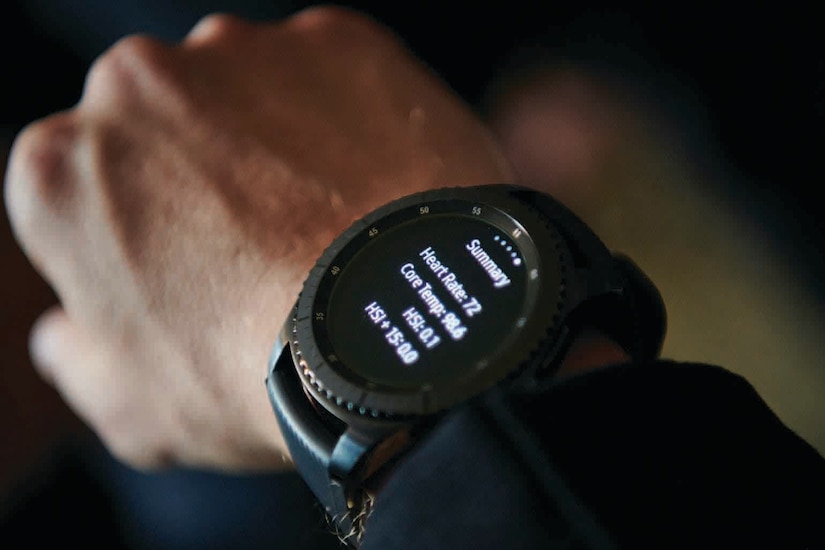
"Making it easier to work with the Defense Department has been an important part of DIU's success," Brown said. "One simple way to do that is to describe problems in language familiar to the private sector rather than in language only the military would understand.
"Next," he continued, "we enable companies to participate in the selection process easily by responding with material they already have. It could be as few as five slides illustrating their solution rather than a long, customized request for proposal. Finally, we work quickly to get to an answer to whether the companies are selected for a prototype contract.
"As proof of the success of DIU's effort to make working with the Defense Department easier," Brown said. "The number of companies submitting to projects is up 40% this year. The DIU has also worked with around 120 non-traditional vendors — those not typically involved in defense contracts — and has attracted 60 companies who have never before worked with the Department to come forward with solutions to help the warfighter.
"Among those projects, is a truly transformative one that uses artificial intelligence for predictive maintenance on military aircraft," Brown said.
"The commercial aircraft world has used predictive maintenance for years. We went to one of the leading vendors and said let's try this with military aircraft.
"When AI-based software accurately predicts what parts of an aircraft will fail next, when that aircraft is in the maintenance depot, those parts can be replaced before they fail," Brown said. "That aircraft will spend less time in the maintenance depot for unscheduled work which, in turn, increases aircraft reliability and readiness and saves taxpayer dollars."
DIU prototyped predictive maintenance originated with the Air Force's E-3 Sentry, the C-5 Galaxy and then with the F-16 Fighting Falcon aircraft. After proving its value with the Air Force resulting in a production contract for a vendor, C3.AI, a company that never thought about pursuing a Defense Department customer. DIU is now working with the Marines and the Army for use in ground-based vehicles and helicopters and hopes to test this technology with the Navy for use in ship maintenance.
"Another DIU project provides real-time video to the naval special warfare community through the use of hand-held quadcopters made by a company founded by a veteran called Shield AI," Brown said. "In addition to real-time video, the small drone has infrared capability to allow operators to clear a building. That potentially saves lives. This is very attractive for any warfighter involved in close urban combat.
"One of DIU's most recent transformative projects coming to fruition is the Blue sUAS initiative that builds on the short-range reconnaissance program for the Army. This Army program is selecting a small drone supplier so that the Army has an alternative to Chinese-made drones. The Blue sUAS initiative standardizes on the product the Army tested, for use across the Services (rather than each Service developing its own requirements and suppliers) and then aggregates the buying power across the federal government so that American suppliers are more economically viable. DIU has made five proven suppliers available to any federal agency through the GSA catalog," Brown said. DIU has already had conversations with the Defense Security Cooperation Agency to offer these American suppliers the opportunity for foreign military sales, as well, "to aggregate that buying power across our allies."
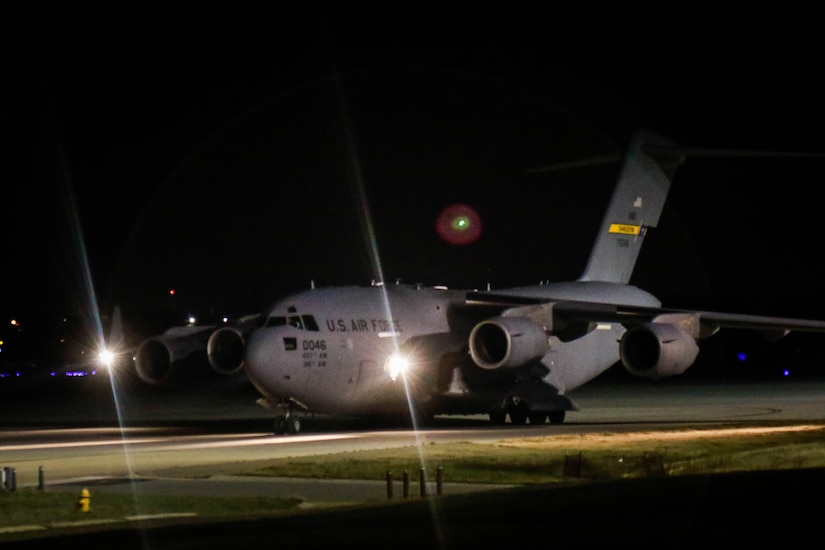
As an example of a project that grew beyond its original intent to a new capability for the military is Kessel Run. It started as a software development prototype for more efficient re-fueling by Air Force tankers and now has scaled into the Kessel Run Agile Software Development methodology, developing multiple software applications for the Air Force.
Right now, Brown thinks DIU is just scratching the surface of what's possible. DIU influences about $500 million to $600 million of procurement every two years — over the course of projects underway, but the Department might buy somewhere between $300 billion and $400 billion in that same two-year period.
"So, there's a lot more that the department buys that might benefit from commercial purchases," he said.
"DIU received a 55% budget increase for FY20 from Congress, and we're using that to expand capacity to do more projects. In fact, we're doing 50% more projects this year than we did last year and that is triple the projects we did in 2018.
"There's also a new element of DIU," Brown said, "called National Security Innovation Capital which was approved in the 2018 NDAA. If that receives funding, DIU will serve as a catalyst to get private money aimed at dual-use hardware technology — like batteries, quantum sensors or space components — that supports departmental priorities where private capital has not typically been invested. In this way, we can grow some of the future suppliers we need in the supply base.
"We're proud of what we've done in our first five years, but there's a lot more to do," Brown said. "There couldn't be a more urgent need for what we're doing in a future where our defense budgets may be under pressure and where China is making large technology bets along with civil-military fusion. DIU is one of the Department's answers in that future."
Louisiana National Guardsmen assist an evacuating citizen at the Burton Coliseum in Lake Charles, La., Aug. 26, 2020, before Hurricane Laura’s landfall. The arena is being used as a transition location to process evacuees and move them to safe locations outside of the storm’s path of Laura.
Aug. 27, 2020
On August 26, Secretary of Defense Mark T. Esper spoke with the Papua New Guinea (PNG) Minister for Defense, Saki Soloma; a historic first call between the defense counterparts. Secretary Esper and Minister Soloma spoke to the importance of upholding international rules and norms and their commitment to defending a free and open Indo-Pacific region. Both leaders reinforced the strength of the bilateral relationship and discussed pressing regional security issues. The principals concluded the conversation by reaffirming their commitment to future cooperation and collaboration in support of mutual interests including the conclusion of a U.S. – PNG Defense Cooperation Agreement.
Aug. 27, 2020 | BY AIR FORCE TECH. SGT. TAMARA DABNEY
In the midst of hurricane season, the fight against COVID-19 rages on, and readiness and response duties continue for members of the Connecticut Army and Air National Guard.
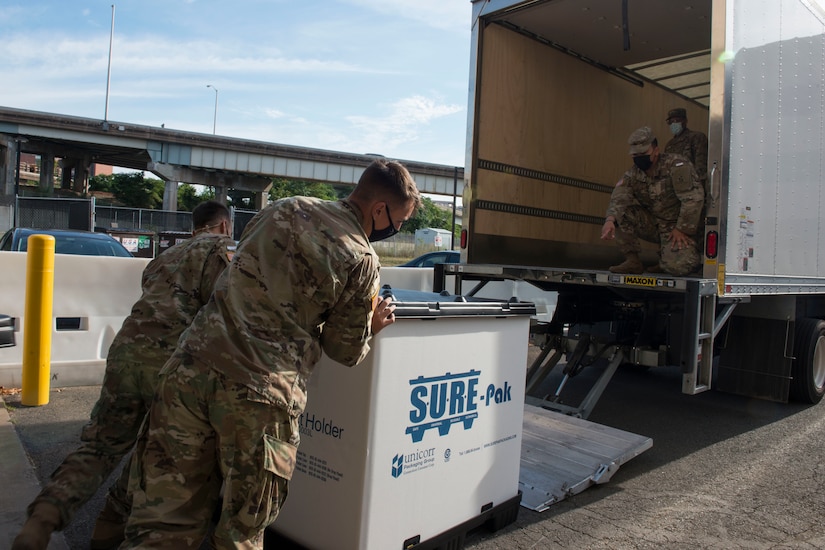
With the rate of new COVID-19 infections in Connecticut currently at a record low, the Connecticut Guard has been able to decrease the number of guardsmen deployed in response to the COVID-19 pandemic. However, the guard remains on high alert as members get ready for a potential second wave of COVID-19 cases. According to Army 1st Lt. James Grindel, member of the Connecticut National Guard Unified Command, small teams of guardsmen have built more than 241,000 COVID-19 sample collection kits that will be transferred to secure storage facilities for now, ready for rapid distribution and application if necessary.
Throughout the pandemic, Connecticut has relied on the guard's ability to deliver and distribute emergency supplies. Now, the state is depending on the guard's logistical expertise during hurricane season. Most recently, Hurricane Isaias tore through Connecticut leaving more than 700,000 homes without power and some without access to clean water. The guard collaborated with the Federal Emergency Management Agency to deliver more than 21,000 cases of water and Meals-Ready-to-Eat, or MREs, to Connecticut residents in the first few days after the storm. The collaboration had a positive impact in the lives of Connecticut residents, said Air Force Chief Master Sgt. Donald Liddell of the 103rd Logistic Readiness Squadron.
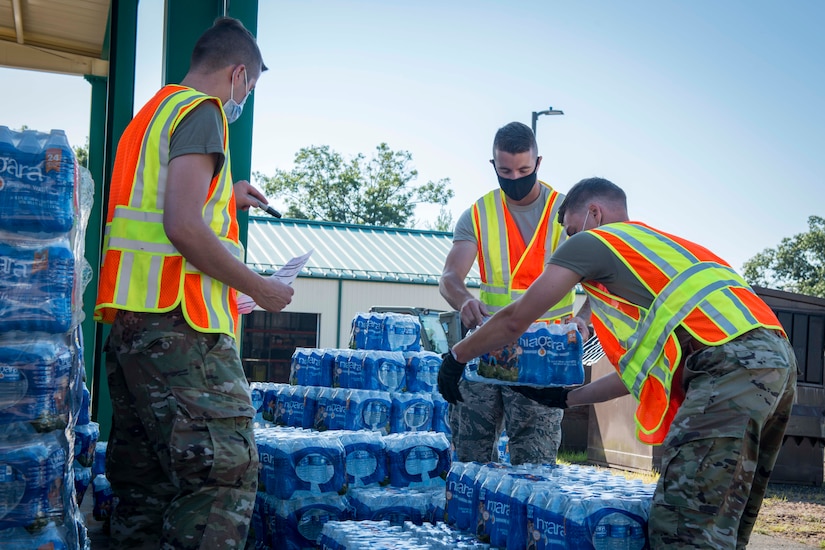
"Throughout all of this, guardsmen have had great attitudes and the work has been hugely impactful," Liddell said. "People are telling us that they couldn't have done it without us, so the work is appreciated throughout the state."
The Connecticut governor often calls the guard to augment the services of other agencies during state emergencies. During Hurricane Isaias, the guard provided supplemental equipment and manpower to aid the utility company in clearing storm debris from roadways.
"We help overwhelmed municipalities or utility companies get areas and routes cleared," said Air Force Sr. Master Sgt. David Frates, emergency management superintendent for the 103rd Civil Engineer Squadron. "What we give the governor is the capability to tap into the training and equipment that we have. We bring it into the neighborhoods and help get people back to where they were before an incident occurred."
Utility company officials are grateful for the support they receive from the guard during mass power outages, said Mike Foley, communications specialist for United Illuminating.

"It's an all hands on deck situation," Foley said. "This effort is really appreciated, because these line crews can get in here quicker, energize the lines and people can turn their lights on sooner."
According to Liddell, the guard will continue to work with various agencies as Connecticut remains at a heightened risk for emergencies.
"We'll be here as long as you need us, and we'll work as long as you need our help," Liddell said.
(Air Force Tech. Sgt. Tamara Dabney is assigned to the 103rd Airlift Wing)
Aug. 27, 2020 | BY ARMY SPC. RYAN LUCAS
As Exercise Saber Junction 20 wound down and the 173rd Airborne Brigade prepared to redeploy to Vicenza, Italy, and Grafenwoehr, Germany, brigade medical personnel administered COVID-19 tests to the entire force, Aug. 21, 2020.
While the brigade finished it's exercise, medical personnel administered 2,500 swabs and rapid testing in Landstuhl, Germany. All tests came back negative for the virus.
''We're conducting 100% testing of the brigade in order to ensure the health and safety of our soldiers and allies during the movement of our troops back to Italy,'' said Army Staff Sgt. Michael Aponte, a laboratory technician in the brigade.
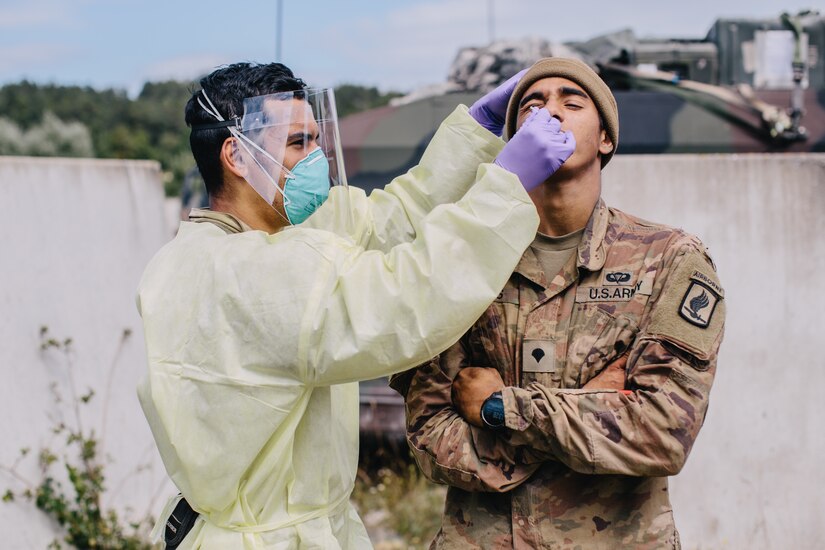
Four battalions of the 173rd Airborne Brigade are based in Vicenza, Italy, while another two are based in Grafenwoehr, Germany. Prior to the beginning of Exercise Saber Junction 20 and the preceding field training exercise in Grafenwoehr Training Area, all Italian-based paratroopers were tested for COVID-19.
''We tested the force in Italy before moving forward to Germany,'' Aponte said. ''Today we're going to take care of the whole brigade and some attachments that we have with us.''
In order to accommodate the testing, the brigade took a tactical pause and temporarily suspended the simulated wartime environment. Spread across the vast Hohenfels Training Area, each battalion sent medical personnel to pick up the testing equipment from the brigade.
''The brigade is providing the tools and each battalion is adjusting to their area of operations,'' Aponte said. The 54th Brigade Engineer Battalion, for example, used one of the simulated towns to carry out their testing, while the Brigade Support Battalion used tents.
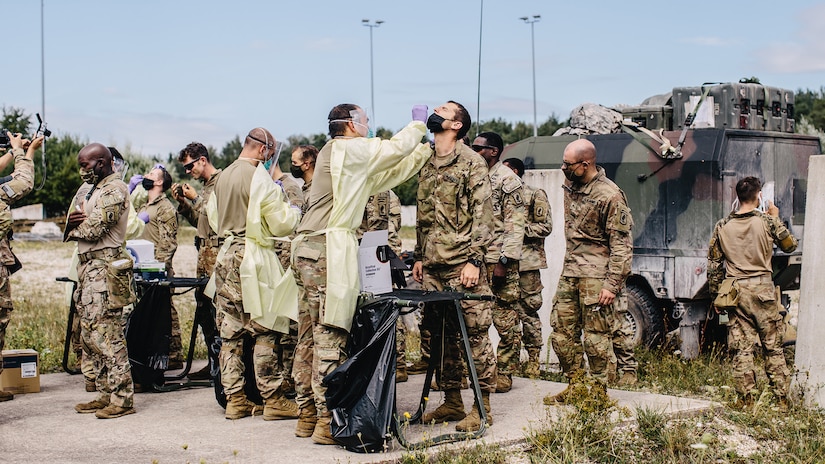
Army Pfc. Frank Croce, a medic assigned to the Brigade Support Battalion, assisted in the testing of 1st Battalion, 503rd Infantry Regiment. Commenting on the testing site, Croce said they were able to set it up very quickly after the tactical pause began.
''It's a hasty setup, but it's effective,'' Croce said.
Once each battalion finished swabbing their entire personnel roster, the brigade collected the samples and shipped them off in a UH-60 Black Hawk for testing. As of Aug. 22, all samples tested negative.
(Army Spc. Ryan Lucas is assigned to the 173rd Airborne Brigade).
Defense Secretary Dr. Mark T. Esper speaks during the Chiefs of Defense conference at the Indo-Pacific Command Headquarters, Hawaii, Aug. 25, 2020. The annual Indo-Pacific Chiefs of Defense conference, co-hosted by the Republic of Fiji Military Forces and U.S. Indo-Pacific Command, took place virtually August 24-2
Aug. 27, 2020 | BY JIM GARAMONE , DOD News
The exercise has been scaled back due to COVID-19, but still had a decent turnout. Australia, Brunei, Canada, France, Japan, New Zealand, Korea, the Philippines, Singapore and the United States are participating. The participating nations sent 22 ships, a submarine and about 5,300 personnel.
Dubbed RIMPAC, this year's exercise focuses solely on warfighting in the maritime domain. This includes anti-surface and anti-submarine warfare, maritime interdiction operations and robust live-fire events, officials said.
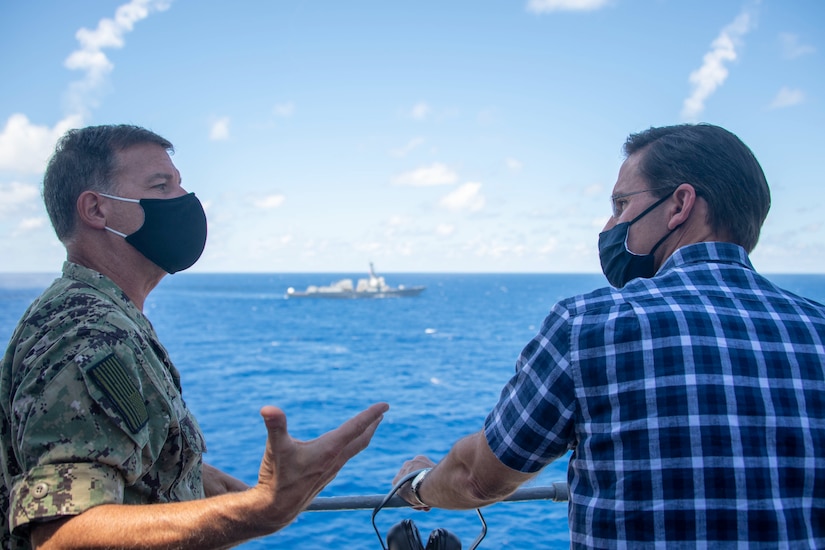
The exercise is held every two years and is an opportunity to strengthen relationships, build trust and increase interoperability among the participating nations, officials said. The nations have to be ready to operate together to respond to threats to international commerce and prosperity or a natural disaster that requires a response from the sea. The U.S. Third Fleet commands the exercise.
On the Essex, Esper met with Navy Adm. John Aquilino, the Pacific Fleet commander. The secretary toured the ship and observed missile and gunfire from the neighboring ships USS Chung-Hoon and USS Lake Erie. He had a private lunch with sailors from various departments aboard the flat top, and he spoke to a socially-distanced group on the ship's hangar deck.
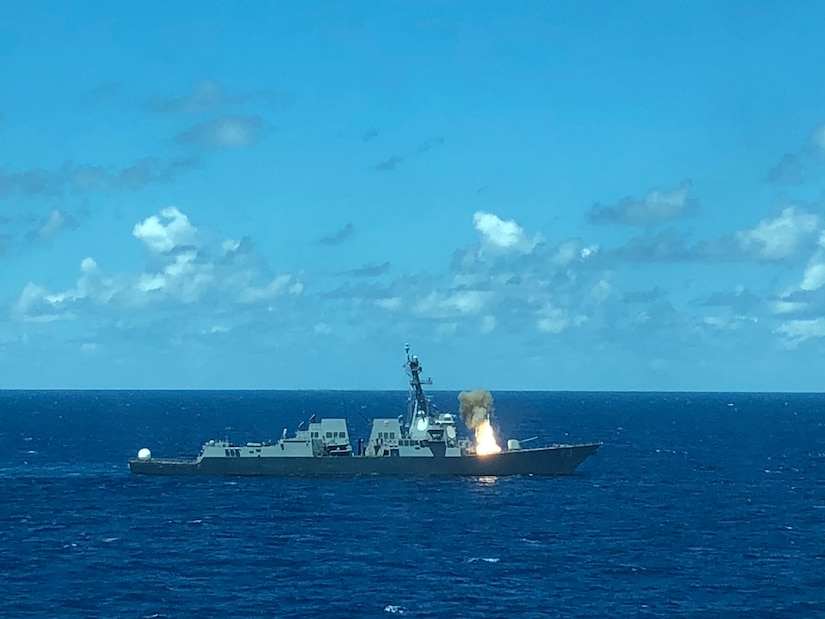
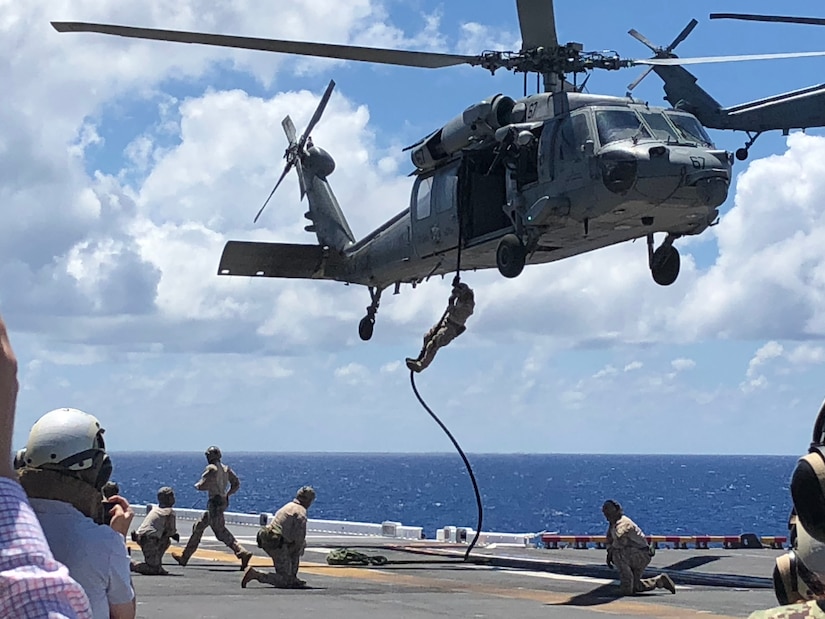
''This ship has incredible capabilities,'' Esper told the sailors. ''It is unique. So much so that the Chinese are trying to mimic its capabilities.
''But they don't have you,'' he continued. ''They don’t have your commitment to service, your skills, your knowledge. They can't compete with us at that level.''
The Essex and her sister ships are in the Pacific to deter China and Russia in this era of great power competition, the secretary said.
''Your presence out here in the Indo-Pacific is all about making sure we compete with China and … if necessary, that you can fight and beat them anytime, anywhere,'' he continued.
The nations participating in RIMPAC do so to learn from each other, Esper said. But they look to the U.S. Navy ''as the standard bearer of what a great navy looks like, how a great navy acts, and performs and behaves,'' he said.
The secretary thanked the sailors for their service and for their ability to fight together as a team.
''You come from all parts of the country, or even outside the country,'' he said. ''You come from all walks of life, and [yet] you come together to fight as one team.''
The sailors all raised their right hand to support and defend the Constitution, he said.
''You're part of the 1 percent who has chosen to do that: to risk your welfare and to sacrifice so that all 338 million other Americans can sleep safely and soundly at night,'' he said. ''Thank you for what you do.''
Aug. 27, 2020
The chief of staff of the Army announces the following general officer assignments:
Maj. Gen. Mark W. Gillette, chief of staff, United Nations Command, Republic of Korea, to senior defense official and defense attaché, U.S. Defense Attaché Office, Egypt.
Brig. Gen. Jacqueline D. Brown, deputy director of command, control, communications and cyber, J-6, U.S. Indo-Pacific Command, Camp H. M. Smith, Hawaii, to director of command, control, communications and cyber, J-6, U.S. Indo-Pacific Command, Camp Smith, Hawaii.
Brig. Gen. Paul T. Stanton, deputy director of operations, J-3, U.S. Cyber Command, Fort Meade, Maryland, to deputy commanding general (operations), U.S. Army Cyber Command, Fort Gordon, Georgia.
Col. (Promotable) Glenn A. Dean III, deputy for acquisition and systems management, Office of the Assistant Secretary of the Army (Acquisition, Logistics and Technology), Washington, D.C., to program executive officer, Ground Combat Systems, Warren, Michigan.
Aug. 27, 2020 | BY JIM GARAMONE , DOD News
Esper said China is threatening the basis for prosperity in the Indo-Pacific region, and like-minded nations must band together.
Allies and partners are crucial in this new era of great power competition, Esper said at a ceremony marking the 25th anniversary of the Daniel K. Inouye Asia Pacific Center for Security Studies. The United States recognizes the dangers and is reaching out to nations around the globe to counter China's moves.
That U.S. network of allies and partners ''remains the enduring asymmetric advantage we have over near-peer rivals, namely China, that attempt to undermine and subvert the rules-based order to advance their own interests – often at the expense of others,'' he said.
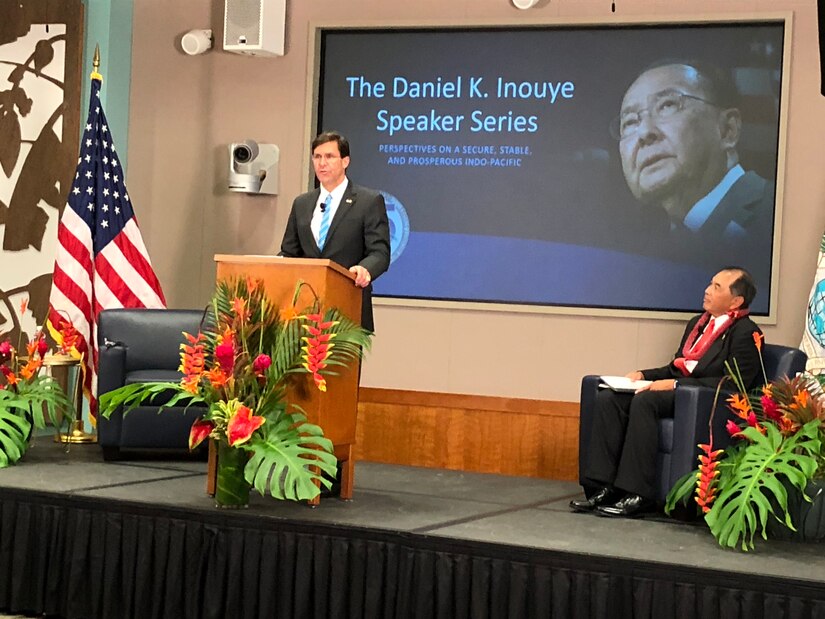
Great power competition is the foremost threat facing the globe, and the United States has made it the foundation of the National Defense Strategy promulgated in 2018.
''One of the goals that drives our implementation of the [strategy] is to focus the department on China,'' he said.
The Defense Department has taken a number of steps including the creation of a new policy office to counter China. There is now a China strategy management office to integrate DOD efforts to deter China.
The National Defense University has shifted its curriculum with 50% of the coursework concerning China. He also decreed that the services make China ''the pacing threat'' in all DOD schools, programs and training.
''These efforts are critical to preparing our military's future leaders for tomorrow's challenges,'' he said.
The Chinese Communist Party – not the people – rule China, and the leaders in Beijing have repeatedly fallen short of their promises, and China does not abide by international laws, rules or norms, Esper said. This is despite continuing to reap the benefits of the international system and free markets.
The Communist Party also reneges on commitments it made, including promises to safeguard the autonomy of Hong Kong and not to militarize features in the South China Sea, the secretary said.
''Beijing's self-serving behavior … is not isolated to just the Indo-Pacific region,'' he said. ''Increasingly, our like-minded partners around the world are experiencing the CCP’s systematic rule-breaking behavior, debt-backed economic coercion and other malign activities meant to undermine the free and open order that has benefitted nations of all sizes – China included.''
Fishing fleets with no care for the ecological and economic damage they create around the world are an example of China flexing its muscles. Beijing has failed to uphold its obligations under the World Trade Organization. Chinese leaders also hampered global efforts to control the coronavirus pandemic due to its lack of transparency with the World Health Organization, Esper said.
There are direct military implications to the Chinese attitude.
''To advance the [Chinese Communist Party's] agenda, the People's Liberation Army continues to pursue an aggressive modernization plan to achieve a world-class military by the middle of the century,'' the secretary said. ''This will undoubtedly embolden the PLA's provocative behavior in the South and East China Seas, and anywhere else the Chinese government has deemed critical to its interests.''
The PLA does not serve the people or swear an oath to a constitution but is the military arm of the Communist Party. It is in league with attempts to undermine rules and norms across the globe, including Djibouti, Sri Lanka, Latin America and Africa.
''Clearly, China seeks to undermine the free and open order itself, which impacts every nation supporting and benefitting from this system,'' he said.
DOD's answer to this is preparedness, strengthening alliances and partnerships, and promoting and expanding a network of like-minded partners.
The United States is focusing on modernizing the force to deter, compete, and, if necessary, fight and win, across all domains: air, land, sea, space, and cyberspace, Esper said.
''Thanks to our largest research and development budget in the department's history, we are prioritizing the development and deployment of game-changing technologies, such as hypersonic weapons, 5G and artificial intelligence,'' he said. ''We are also investing in platforms critical to the future of a free and open Indo-Pacific, such as submarines, B-21 stealth bombers, P-8 maritime patrol aircraft, unmanned underwater and surface vehicles, long-range precision munitions, integrated air and missile defense, and a new class of frigates.''
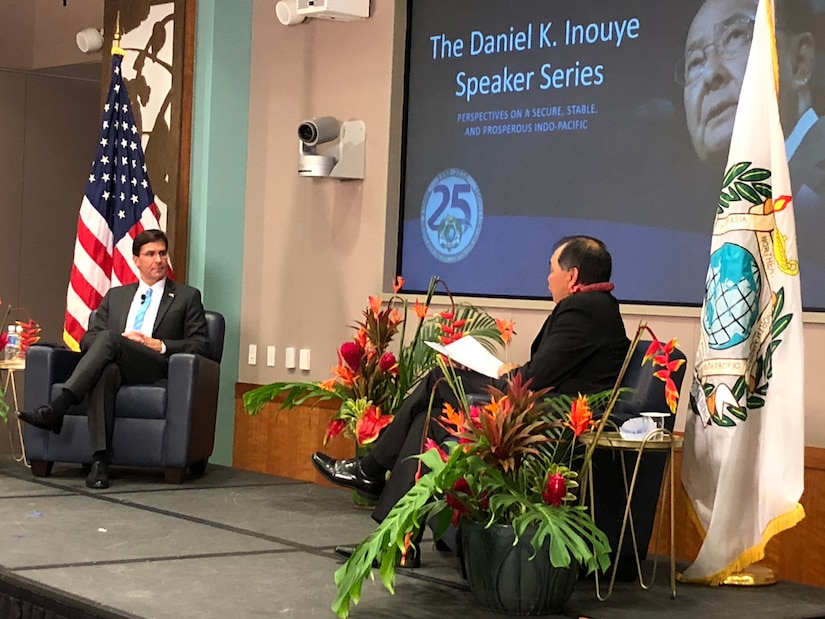
But it is not just equipment. DOD is developing a new Joint Warfighting Concept for the 21st century. Part of that is making the U.S. military more strategically predictable to our partners, and operationally unpredictable to our competitors, Esper said.
''These efforts prepare our military for future conflicts that we hope we won't need to fight, but must – and will – be prepared to win,'' he said.
Allies and partners are key in this struggle. DOD must assist countries across the region to develop their national security policies, strategies, plans, and laws.
''This type of work — with nations such as Bangladesh, Mongolia, the Philippines and several Pacific Island nations — has helped put like-minded partners on a path toward greater preparedness, enabling them to become more confident in their sovereignty,'' he said.
Allies and partners provide an asymmetric advantage adversaries do not have.
''Our shared security concerns and desire to maintain a free and open Indo-Pacific have yielded countless bilateral and multilateral initiatives throughout the region aimed at strengthening and expanding defense cooperation and alignment,'' Esper said.
Part of this process is through an improved and expanded foreign military sales program.
''By streamlining the FMS process, we have lowered costs and accelerated our response time to partner nation requests, allowing us to deliver critical capabilities more quickly and effectively,'' he said.
The United States is working with long-established allies, including Australia and Singapore, and with other nations in South Asia, Southeast Asia and Oceania.
Bilateral alliances are good, but multilateral efforts are better. Promoting a more networked region encourages the growth of inter-connected security partnerships, Esper said. This is a force multiplier for nations that share U.S. interests.
''As we continue to implement our Indo-Pacific strategy, the United States needs our allies and partners to contribute in ways that are fair and equitable,'' the secretary said. ''We need them to pursue close alignment in policies that uphold a free and open order, and reject decisions that would benefit malign actors to our collective detriment. And, we need them to make the necessary investments to improve their capabilities so that, together, we can safeguard our interests, strengthen our readiness, and defend our sovereignty and values.''